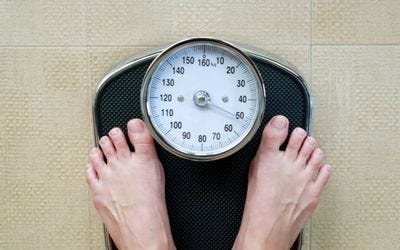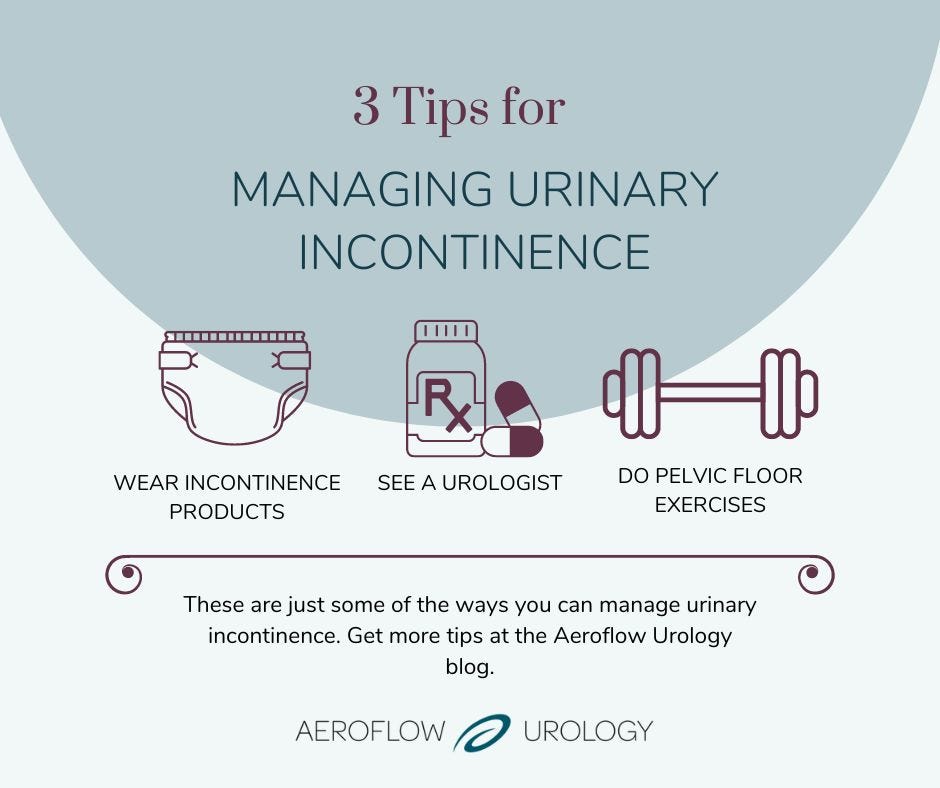Obesity is a complicated condition that has become an epidemic in the US, affecting around 160 million Americans.
It’s widely known that the disease can cause heart attack, cancer, diabetes, stroke, and even death, but a lesser-known symptom of obesity is urinary incontinence.
While urinary leakage may seem unworthy of our attention, it actually causes a decrease in quality of life.
This post will teach you:
- How obesity and urinary incontinence are related.
- How to manage your weight.
- How to treat symptoms of urinary incontinence.
- How to get free incontinence supplies through your insurance.
Check Your Eligibility
2 Easy Steps
Discover the continence care essentials available through your Medicaid plan.
Urinary Incontinence
Urinary incontinence is the unintentional loss of bladder control. This loss of control usually leads to urine leakage.
The different types of urinary incontinence are:
Stress Urinary Incontinence: When extra pressure on the bladder or weak pelvic floor muscles causes you to leak urine when sneezing, coughing, laughing, exercising, or lifting heavy objects.
Overactive Bladder (OAB): Feeling like you need to void your bladder more frequently than usual, resulting in peeing more than 8 times in 24 hours.
Overflow Incontinence: Being unable to empty your bladder completely, leading to leftover urine overflowing or dribbling throughout the day.
Mixed Incontinence: Experiencing symptoms of more than one type of incontinence.
Anyone can experience urinary incontinence, from men and women to children as young as 5.
The causes of urinary incontinence usually include:
- Weak or damaged pelvic floor muscles.
- Hormonal changes experienced during menopause, pregnancy, or menstruation.
- Obesity or being overweight.
- Certain medications.
- Conditions such as autism, Spina bifida, etc.
- Nerve damage.
- Aging
Obesity
Obesity is a disease that has to do with having too much excess body weight. The condition puts those experiencing it at serious risk of heart disease, cancer, stroke, diabetes, death, and urinary incontinence.
Obesity is common in America, affecting 14.7 million children and adolescents and carrying a prevalence of 41.9% among adults.
Diagnosis
Obesity is diagnosed by calculating body mass index (BMI), a screening tool used in the healthcare community. To determine BMI, healthcare professionals use the following algorithm:
Your weight (kg) divided by your height (m) = Your BMI.
Your resulting BMI tells the amount of fat you have on your body.
The Centers for Disease Control and Prevention use this BMI chart to indicate whether someone is obese or overweight:
- If your BMI is under 18.5, you are in the underweight range.
- If your BMI is 18.5 to <25, you are in a healthy weight range.
- If your BMI is 25.0 to <30, you are in the overweight range.
- If your BMI is 30.0 or higher, you are in the obesity range.
The CDC also divides obesity into three subcategories:
- Class 1: BMI of 30 to < 35.
- Class 2: BMI of 35 to < 40.
- Class 3 (severe obesity): BMI of 40 or higher.


Causes & Risk Factors
The causes of obesity vary. You can become obese due to:
- Genetics or family history of obesity.
- Metabolism issues, such as insulin resistance.
- Hormonal problems, such as hypothyroidism.
- Lifestyle choices, like not getting enough exercise or eating too many processed foods.
- Behavioral issues, such as eating more due to anxiety or stress.
While these causes contribute to obesity, the main culprit is eating more calories than your body can burn.
When you eat, the calories in food are either used as energy during regular activity or exercise or stored for later use. If you fail to burn more calories than you consume, those excess calories are turned into fat and build up in your body, causing weight gain and obesity.
The diet of Americans is another significant cause of the disease; It’s reported that 46% of people in the country have poor diets or make poor dietary choices. These diets are typically:
- Low in fruits.
- Low in vegetables.
- Low in fish.
- Low in whole grains.
- High in sodium (salt).
- High in fat.
- High in processed meats.
- High in calorie count.
- High in sugars.
- Large in portion size.


People who are obese have increased risks of developing severe chronic diseases, such as:
- Heart disease.
- Hypertension
- Sleep apnea.
- Cancer
- Type 2 diabetes.
How Obesity & Urinary Incontinence Are Related
The prevalence of obesity is rising quickly; It’s estimated that by 2030, 1 billion people will be living with obesity around the world.
This means that the number of people experiencing urinary incontinence will likely be on the rise around the same time since it has been proven that obesity is a risk factor for urinary incontinence.
When you are obese, the extra fat on your body— specifically in your midsection— places extra pressure on your bladder, urethra, and pelvic floor muscles. This is referred to as intra-abdominal pressure and can result in:
- Bladder contractions.
- A less mobile urethra.
- Chronic stretching and strain on pelvic floor muscles.
Whether you experience them alone or together, these results usually lead to stress urinary incontinence, overactive bladder, urge incontinence, or mixed incontinence. This is because:
1. Bladder contractions are part of what makes you feel the urge to urinate. When your bladder is contracting more than expected due to extra pressure, you may feel the need to void more frequently.
2. A mobile urethra helps you have urinary continence (bladder control) by opening and closing your urethral sphincter when peeing or holding your pee. When pressure is placed on your pelvic floor muscles, it damages the urethra, making it less able to do its job correctly, leading to unintentional urine leakage.


3. Your pelvic floor muscles act as a hammock to your internal urinary organs. These muscles hold everything in place and give your core and urinary system strength. The extra pressure from excess weight placed on these muscles causes long-term strain and stretching of the muscles, which causes weakness, leading to pelvic floor disorders.
Manage Your Weight
Studies have proven that for every 5-unit increase in your BMI number, you are 60% to 100% more likely to develop urinary incontinence, so it’s essential to do what you can to manage your body weight to avoid symptoms and, most importantly, stay healthy.
Use these tips to manage your weight in a healthy, safe way.
1. Make Lifestyle Changes
Making lifestyle changes, such as exercising, eating a healthy diet, and visiting your healthcare provider, can help you maintain a healthy weight.
Exercise
Getting enough exercise is not only good for your overall health, but it can also aid in weight loss (and pelvic floor health!).
The CDC recommends that adults get 150 minutes of moderate exercise, such as brisk walking or swimming, every week, with 2 of those days spent doing 150 minutes of muscle strengthening exercises, such as weight lifting.
If you are just starting, try walking every day for the recommended amount of time. If you aren’t ready for 150 minutes per week, try to walk for as long as you can each day and build up from there.
You can also try small changes, such as taking stairs instead of elevators, walking on breaks at work, or biking instead of driving.


Diet
Since diet is a prominent cause of obesity in America, it should be at the front of your mind when managing your weight.
Avoid foods high in saturated fat and sugar and are heavily processed, and remember that you need to burn more calories than you eat in a day.
While it’s recommended that men consume 1,900 calories a day and women eat 1,400, you don’t need to count calories. Instead of calorie counting (which can be time-consuming and may trigger eating disorders), choose foods that are good for you, such as:
- Fresh fruits and vegetables.
- Whole grains.
- Lean proteins.
- Heart-healthy fish.
- Nuts and seeds.
Bonus: Eating a healthy diet can also support a healthy urinary system!
Doctor's Visits
Don’t miss those follow-up visits with your healthcare provider if you’re trying to manage your weight.
Getting professional advice can help you go about weight loss safely and healthily. Your healthcare provider may also be able to tell you your BMI and recommend support groups, weight loss programs, meal recommendations, and exercises that are right for your body.
You may also receive surgical procedure recommendations for weight reduction, such as bariatric surgery.
Manage Stress
Stress and anxiety can lead to behavioral issues related to overeating. Try stress-reducing techniques, such as meditation, exercising, or journaling to reduce stress.
2. Find Support
Lifestyle changes may sound simple, but they can be difficult for some.
Weight loss groups, whether they’re local or virtual, can be beneficial when attempting to lose weight. Ask your healthcare provider for recommendations or search online to find a group.
The effects of weight loss can also positively impact your lifestyle and can change what you do in your free time. Support groups may help you find a new group of friends to enjoy newfound activities.
3. Set Realistic Goals
Set achievable goals rather than setting drastic weight loss goals that may cause you to engage in unrealistic or unsafe dieting plans.


If you are obese, try setting a goal to lose 3% of your body weight. Losing this percentage of weight can decrease your risk of developing other related morbidities like heart disease and cancer.
4. Keep Track of Progress
Monitoring your progress is an excellent way to give yourself positive reinforcement throughout your weight loss journey.
Keep a journal and record your BMI every few months, and remember that change takes time and that every little bit of effort counts!
People who are obese or overweight typically see weight loss results at around 8 weeks, so just because you don’t see immediate results doesn’t mean you aren’t going to lose weight.
Treating Urinary Incontinence
If you are obese and experiencing urinary incontinence, there are many things you can do to manage symptoms.
1. Wear Incontinence Products
Incontinence products, such as adult briefs, pull-ons, or bladder pads, can help you manage leakage and stay confident throughout your day.
These products' ultra-absorbent cooling materials can soak up unexpected urine leaks and keep you cool and dry while going about your normal activities.
The best part is that you may be able to get free incontinence supplies like these through Aeroflow Urology and your insurance plan.
To see if you qualify, fill out our Eligibility Form.


If you do qualify, one of our Continence Care Specialists will reach out to you to answer any questions you may have and send you free incontinence supply samples to be sure you’re picking the right product for your lifestyle and body.
Currently, Aeroflow Urology carries adult briefs and pull-ons in larger sizes:
- 2XL (80” waist).
- 3XL (100” waist).
After choosing your products, they’ll be shipped free directly to your doorstep in discreet packaging every month. We’ll even send you a text message or email reminder to tell you when you need to reorder so you won’t run out of supplies.
2. See a Urologist
A healthcare professional in the field of urology can help you narrow down what type of incontinence you’re experiencing and guide you on how to treat symptoms.
A urologist may also recommend specific exercises to increase pelvic floor strength, medications to reduce incontinence symptoms, and surgeries to help lessen leakage.
3. Do Pelvic Floor Exercises
Alongside exercising to lose or manage weight, try pelvic floor exercises, such as Kegels, to bring strength back to your pelvic floor muscles. Even though most people think Kegels are a great way to maintain only women’s health, men can do them, too!
Qualify for Free Incontinence Supplies
To see if you qualify for free incontinence supplies today, fill out our short Qualify Form!
World Obesity Atlas 2022. (n.d.). World Obesity Federation. https://www.worldobesity.org/resources/resource-library/world-obesity-atlas-2022
Subak, L. L., Richter, H. E., & Hunskaar, S. (2009). Obesity and Urinary Incontinence: Epidemiology and Clinical Research Update. Journal of Urology, 182(6S). https://doi.org/10.1016/j.juro.2009.08.071
Mozaffarian, D. (n.d.). A nutrition report card for Americans: Dark clouds, silver linings. The Conversation. https://theconversation.com/a-nutrition-report-card-for-americans-dark-clouds-silver-linings-156200#:~:text=Almost%20half%20of%20U.S.%20adults
Rakhra, V., Galappaththy, S. L., Bulchandani, S., & Cabandugama, P. K. (2020). Obesity and the Western Diet: How We Got Here. Missouri Medicine, 117(6), 536–538. https://www.ncbi.nlm.nih.gov/pmc/articles/PMC7721435/#:~:text=The%20typical%20Western%20(American)%20diet
CDC. (2022, March 17). Move More; Sit Less. Centers for Disease Control and Prevention. https://www.cdc.gov/physicalactivity/basics/adults/index.htm#:~:text=Each%20week%20adults%20need%20150
The vast majority of American adults are overweight or obese, and weight is a growing problem among US children. (2014, May 23). Institute for Health Metrics and Evaluation. https://www.healthdata.org/news-release/vast-majority-american-adults-are-overweight-or-obese-and-weight-growing-problem-among#:~:text=An%20estimated%20160%20million%20Americans
Mayo Clinic. (2021, September 2). Obesity - symptoms and causes. Mayo Clinic; Mayo Clinic.https://www.mayoclinic.org/diseases-conditions/obesity/symptoms-causes/syc-20375742
Information provided on the Aeroflow Urology blog is not intended as a substitute for medical advice or care from a healthcare professional. Aeroflow recommends consulting your healthcare provider if you are experiencing medical issues relating to incontinence.









